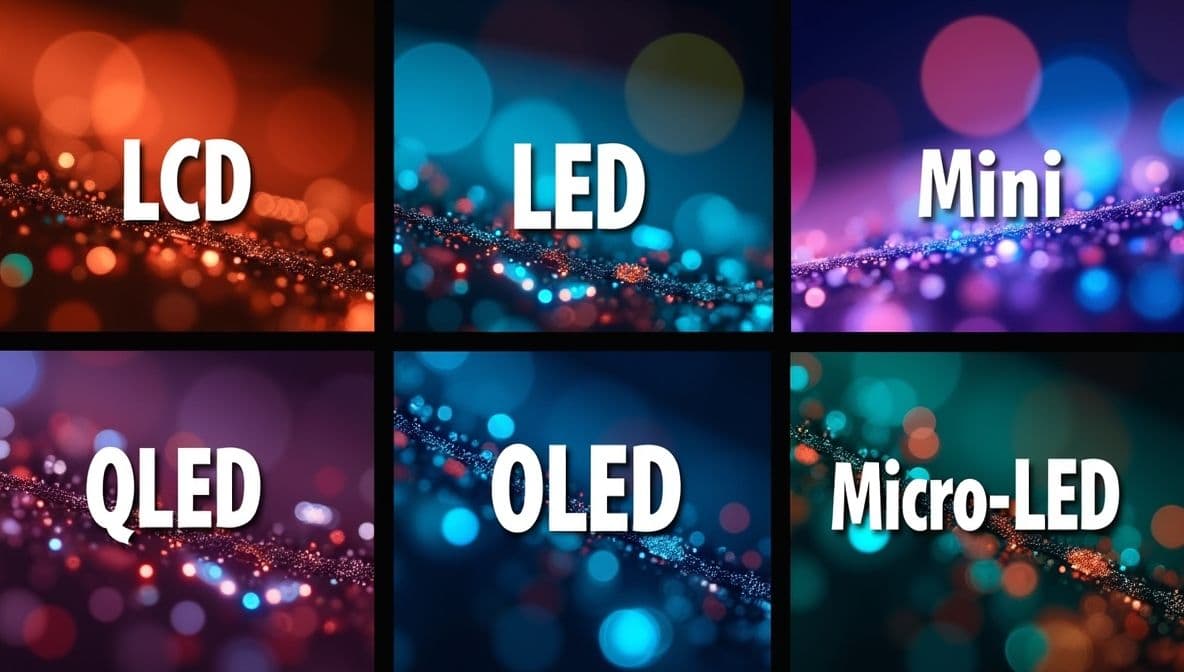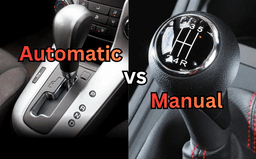Planning to Buy a TV? Here's a Complete Guide to Choose the Perfect Screen

Walking into an electronics store or browsing online can feel like decoding a foreign language—LED, QLED, OLED, Mini-LED... what does it all mean? Don't worry! This comprehensive guide breaks down every TV display technology in simple terms, helping you make the right choice for your home and budget.
LCD TV (Liquid Crystal Display)
LCD TVs were the first flat-panel technology to replace bulky CRT televisions. They use a liquid crystal layer that blocks or allows light to pass through, creating images on screen.
How It Works
LCD TVs use a CCFL (Cold Cathode Fluorescent Lamp) backlight behind the liquid crystal panel. The crystals twist or untwist to control light passage, creating the picture you see.
Advantages
- Most affordable option available
- Reliable and proven technology
- Decent picture quality for basic viewing
- Low power consumption compared to older CRT TVs
Disadvantages
- Bulkier than LED TVs due to CCFL backlighting
- Poor black levels and contrast
- Limited viewing angles
- Less energy efficient than LED alternatives
- Slower response time (not ideal for gaming or sports)
- CCFL backlights contain mercury
Note: Pure LCD TVs with CCFL backlighting are largely discontinued. Most "LCD TVs" sold today are actually LED-LCD TVs.
LED TV (LED-Backlit LCD)
LED TVs are technically LCD TVs that use LED backlighting instead of CCFL. This is the most common TV technology on the market today.
Types of LED TVs
Edge-Lit LED
LEDs are positioned around the edges of the screen, with light distributed across the panel using a light guide.
Advantages:
- Ultra-thin design
- More affordable
- Lower power consumption
Disadvantages:
- Uneven brightness (edges brighter than center)
- Poor local dimming performance
- Limited contrast ratio
Direct-Lit LED (Full-Array)
LEDs are placed directly behind the entire screen in a grid pattern.
Advantages:
- More uniform brightness
- Better contrast than edge-lit
- Improved local dimming capability
Disadvantages:
- Slightly thicker than edge-lit models
- More expensive than edge-lit
- Still limited by number of dimming zones
Full-Array Local Dimming (FALD)
An enhanced direct-lit system where LEDs are organized into independently controllable zones.
Advantages:
- Significantly better contrast and black levels
- Improved HDR performance
- More precise brightness control
- Better overall picture quality
Disadvantages:
- More expensive
- Can cause "blooming" effect around bright objects
- Number of zones varies widely (32 to 500+)
Overall LED TV Advantages
- Thinner and lighter than LCD
- Energy efficient
- Good brightness levels
- Wide variety of sizes available
- Mercury-free
- Faster response time than traditional LCD
Overall LED TV Disadvantages
- Black levels not as deep as OLED
- Viewing angles can be limited (especially VA panels)
- Backlight bleed possible on cheaper models
- Contrast dependent on local dimming quality
Mini-LED TV
Mini-LED represents a significant evolution in LED-LCD technology, using LEDs that are approximately 0.2mm in size—much smaller than traditional LEDs.
How It Works
Thousands of tiny LEDs are packed behind the screen, creating many more dimming zones (often 500 to 2,000+ zones) compared to traditional FALD systems.
Advantages
- Exceptional contrast and black levels (approaching OLED)
- Outstanding HDR performance
- Minimal blooming effect
- Extremely high brightness (1,000-2,000+ nits)
- No burn-in risk
- Excellent for bright rooms
- Great for gaming with high refresh rates
- Better than OLED in very bright content
Disadvantages
- Premium pricing compared to standard LED
- Still can't achieve perfect blacks like OLED
- Slightly thicker than OLED
- Viewing angles not quite as good as OLED
- Power consumption higher than OLED
Popular Models: TCL 6-Series, Hisense U8, Samsung QN90 series
QLED TV (Quantum Dot LED)
QLED is Samsung's premium brand name for TVs that combine LED backlighting with quantum dot technology. Other manufacturers use similar technology under names like "Quantum Dot" or "NanoCell."
How It Works
A quantum dot film layer sits between the LED backlight and LCD panel. These nanocrystals absorb blue light from LEDs and re-emit it as precise red and green wavelengths, creating purer colors.
Advantages
- Superior color accuracy and volume
- Exceptional brightness (1,000-2,000+ nits)
- Excellent HDR performance
- No burn-in risk
- Great for bright rooms and sports
- Often includes Mini-LED backlighting (premium models)
- Long-lasting brightness
- Wide color gamut
Disadvantages
- Black levels inferior to OLED (unless Mini-LED version)
- Viewing angles limited compared to OLED
- Premium pricing
- Still relies on backlight (not self-emissive)
- Local dimming limitations on non-Mini-LED versions
Popular Models: Samsung Q60-Q90 series, Sony X95 series, TCL QM8
OLED TV (Organic Light Emitting Diode)
While not LED-backlit LCD technology, OLED is worth including as it's a major competitor to high-end LED/QLED TVs.
How It Works
Each pixel is a self-emissive organic compound that produces its own light. No backlight needed—pixels can turn completely off for perfect blacks.
Advantages
- Perfect black levels and infinite contrast
- Exceptional viewing angles
- Superior motion handling
- Faster response time (ideal for gaming)
- Thinner design
- Better uniformity (no backlight issues)
- Outstanding picture quality in dark rooms
Disadvantages
- Risk of burn-in with static content
- Lower peak brightness than QLED/Mini-LED
- Premium pricing
- Not ideal for very bright rooms
- Brightness degrades over time
- Limited lifespan compared to LED
Popular Models: LG C/G series, Sony A80/A95 series
Micro-LED TV
Micro-LED is the newest and most advanced display technology, using microscopic LEDs as individual pixels.
How It Works
Each pixel is a tiny LED that emits its own light (like OLED), but using inorganic LED technology instead of organic compounds.
Advantages
- Perfect blacks like OLED
- Extreme brightness (superior to OLED and QLED)
- No burn-in risk
- Infinite lifespan (theoretically)
- Best of both LED and OLED worlds
- Exceptional color accuracy
- Superior energy efficiency
Disadvantages
- Extremely expensive and premium
- Very limited availability
- Mostly available in ultra-large sizes (100"+)
- Manufacturing complexity
- Limited consumer options
Availability: Primarily Samsung "The Wall" series, limited commercial availability
Quick Comparison Table

Which TV Should You Buy?
Choose LCD/LED if:
- You're on a tight budget
- You need a basic TV for casual viewing
- You're buying a secondary/bedroom TV
Choose FALD LED if:
- You want good value for money
- You watch a mix of content types
- You need a reliable all-rounder
Choose Mini-LED if:
- You have a bright viewing environment
- You love HDR content and gaming
- You want near-OLED performance without burn-in risk
Choose QLED if:
- You prioritize brightness and color
- You watch lots of sports and daytime TV
- You want a premium experience with no burn-in worries
Choose OLED if:
- You primarily watch in dark/dim environments
- Picture quality is your top priority
- You don't display static content for long periods
- You're a serious movie enthusiast or gamer
Choose Micro-LED if:
- You want the absolute best technology available
- You need a massive screen (100"+)
- You're seeking cutting-edge display technology
Final Thoughts
The TV market has evolved tremendously, offering something for every budget and preference. While traditional LCD TVs are being phased out, LED technology dominates the market with excellent options at every tier. Mini-LED and QLED offer the best balance of performance and value for most buyers, while OLED remains the king of picture quality for dark room viewing. Micro-LED represents the future but remains out of reach for most consumers.
Consider your viewing environment, usage patterns, and content preferences when making your decision. The "best" TV is the one that fits your specific needs—not necessarily the one with the most advanced technology.
Pro Tip: Regardless of technology, look for features like 4K resolution, HDR support (HDR10, Dolby Vision), adequate HDMI 2.1 ports for gaming, and smart TV functionality that suits your streaming needs.
Related Posts
 Why India Can't Afford to Miss the AI Race
Why India Can't Afford to Miss the AI RaceNovember 13, 2025



